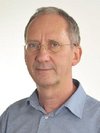On June 8, 2023, two 11th grade students from the Bertha-von-Suttner-Gymnasium, together with a team led by Prof. Dr. Achim Brauer from the GFZ German Research Centre for Geosciences, took two sediment cores in the Heiliger See in Potsdam as part of the project "Getting to the bottom of the Heiliger See". The two students will now search the sediment core for traces of an Icelandic volcanic eruption in 1875. This represents an important time marker for determining the age of the sediments. Dating the sediments as precisely as possible is important for the overall project goal: The sediments should ultimately serve as an archive. To this end, the young researchers are investigating the question of what traces the work on the Neuer Garten and especially the construction of the Mamorpalais have left behind in the lake. For when building or planting is carried out on the shore, erosion causes organic and inorganic material such as pollen, sediments or stone dust from the surroundings to enter the lake.
Within the framework of "Jugend forscht", a project is being carried out for the second time at Heiliger See for the second time this year. The Prussian Palaces and Gardens Foundation Berlin-Brandenburg (SPSG) has joined as a new project partner in 2023. Last year, students had also examined two sediment cores from the lake for organic material as part of their seminar work. They also took water samples and analyzed them at school for various parameters such as nitrate and phosphate.
Scientific support from the GFZ
The Climate Dynamics and Landscape Evolution Section of the GFZ supports the students in the collection of the sediment cores as well as in the subsequent analysis in the laboratory. In this way, the students are introduced to scientific work. Section head Prof. Dr. Achim Brauer is always surprised at how well everything works: "The cooperation is very gratifying and I really enjoy seeing how quickly the students learn. They are very motivated and achieve great results."
The projects are juried into the "Jugend forscht" competition and achieved very good placements at the state level last year. In the coming years, the Bertha-von-Suttner Gymnasium will intensify and further expand these collaborations with scientific institutions due to its participation in the nationwide project "Leistung macht Schule" (promoting giftedness).
"For the Gymnasium, cooperation with extracurricular institutions such as the GFZ is of paramount importance. The students experience principles of scientific work in the context of a regional research topic. This is the best preparation for university studies," says the teacher in charge, Dr. Jochen Woller.
Cooperation with the Prussian Palaces and Gardens Foundation (SPSG).
Due to the promising results of last year's project, the topic is interesting for further scientific research on the development of the New Garden and the traces left in the lake. Therefore, the GFZ team is planning a longer-term cooperation with the Berta-von-Suttner-Gymnasium and the SPSG in the future.
The SPSG is very happy to support this project as part of the cooperation. The historic UNESCO World Heritage Parks and Gardens of Potsdam are also acutely threatened by climate change. It is therefore particularly important that young people take an interest in scientific topics and research methods relating to gardens and the climate. Acquisition of knowledge and committed action lead to identification with the cultural heritage - a prerequisite for preserving it for future generations.
Research at Heiliger See in the last year
It all started in 2022 when students Fabian Marg and Leonard Raupach read reports in local newspapers about problems with nutrients in Heiligen See in Potsdam. The lake is located in the middle of the historic UNESCO World Heritage Parks and Gardens. They said that over the past two decades, the lake's water quality had dropped significantly due to nutrient inputs. This is bad for flora and fauna, they said, because often the various species of animals and plants are adapted to low nutrients and are also well adapted to them. The ecological balance is permanently disturbed by an excess of nutrients. So the students took the initiative and used the reports as an opportunity to find out scientifically what the actual condition of the lake is.
Over the course of a year, they conscientiously took water samples from the lake and analyzed them at school for various parameters such as nitrate and phosphate. The focus was on the progressive eutrophication (nutrient oversupply) of Heiligen See and the effects of the development of the shore and the transformation of the city of Potsdam. At GFZ, they investigated complementary changes in organic matter in two sediment cores.
Last year, the students chose a site next to the EJF daycare center "Am Heiligen See" and at the mouth of the Hasengraben into Heiligen See to measure the electrical conductivity as well as the phosphate, nitrate and oxygen content.
Prof. Achim Brauer and graduate geoecologist Brian Brademann from the German GeoForschungsZentrum had guided the students in taking the sediment cores from an inflatable boat last June. With the help of sonar, the first step was to determine the appropriate location for core removal. After the cores were taken in 1.5 m long plastic tubes, they were transported to the GFZ and stored there in the cold room at 4-6°C.
The students' laboratory work began with the opening of the sediment cores and a detailed description and picture documentation. After further preparation of the cores, they took samples and, under the guidance of Dr. Birgit Schröder, head of the isotope laboratory at GFZ, determined the proportion of inorganic and organic carbon and nitrogen in the samples and measured their stable isotope ratios.
Youth research results 2022: Heiliger See not eutrophied after all
The two students determined the input of organic materials into the lake last year. The phosphate content of the lake was significantly higher than usual for a nutrient-poor lake. While this indicated an accumulation of nutrients in the lake, the low nitrate levels and oxygen levels were indicative of a nutrient-poor condition of Heiliger See. In addition, since organic materials are decomposing in Heiliger See and the lake is going through the "normal" lake cycle, it is indeed safe to assume that Heiliger See remains a nutrient-poor lake, according to the young researchers.
Everyone involved is excited to see what results the 'Jugend forscht' project at Heiliger See will produce this year and would like to thank the researchers who are again actively supporting the young people this year.


![[Translate to English:] Taking sediment cores at Heiliger See: three persons on a raft, in the background the Neuer Garten with the Marmorpalais.](/fileadmin/_processed_/a/a/csm_Jugend_forscht_Heiliger_See_Ausschnitt_copyright_Brauer_77f53d91c1.jpeg)
![[Translate to English:] The project participants on the shore of the Heiliger See with special boat](/fileadmin/_processed_/d/f/csm_Jugend_forscht_am_Heiligen_See_Gruppenbild_2_copyright_Jochen_Woller_12ad2de883.jpeg)

